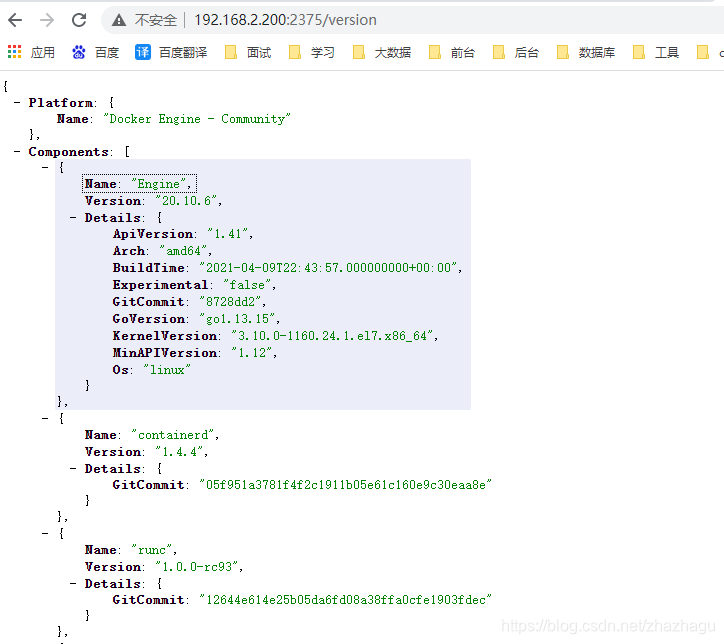centos下docker安装以及springboot远程发布docker
本文共 2667 字,大约阅读时间需要 8 分钟。
centos下docker安装以及springboot远程发布docker
1.CentOS7.0下JDK1.8的安装
(1)到Oracle官网下载好 jdk-8u291-linux-i586.tar.gz备用
(2)卸载系统自带的javajava -versionrpm -qa | grep javayum -y remove [上面查出来的内容,多个用空格分隔]
(3)安装jdk
mkdir /usr/javacd /usr/javatar -zxvf jdk-8u291-linux-i586.tar.gz
(4)配置环境变量
vim /etc/profile
添加下面内容
export JAVA_HOME=/usr/java/jdk1.8.0_291export PATH=$JAVA_HOME/bin:$PATHexport CLASSPATH=.:$JAVA_HOME/lib/dt.jar:$JAVA_HOME/lib/tools.jar
使环境变量生效
source /etc/profile
测试
java -version
2.Docker的安装
(1) 查看内核版本(Docker需要64位版本,同时内核版本在3.10以上,如果版本低于3.10,需要升级内核)
uname -r

(2) 更新yum包:
yum update -y
(3) 添加阿里云yum仓库:
cd /etc/yum.repos.d/wget "http://mirrors.aliyun.com/repo/Centos-7.repo"mv CentOS-Base.repo CentOS-Base.repo.bakmv Centos-7.repo CentOS-Base.repo
执行yum源的更新命令
yum clean allyum makecacheyum update
(4) 安装Docker
yum install -y docker-ce
(5) 启动Docker
启动,查看信息systemctl start dockerdocker info
![[外链图片转存失败,源站可能有防盗链机制,建议将图片保存下来直接上传(img-H5LW4OhZ-1619537409080)(imgclip_1.png "imgclip_1.png")]](https://img-blog.csdnimg.cn/20210427233220511.png?x-oss-process=image/watermark,type_ZmFuZ3poZW5naGVpdGk,shadow_10,text_aHR0cHM6Ly9ibG9nLmNzZG4ubmV0L3poYXpoYWd1,size_16,color_FFFFFF,t_70)
后续可以设置开机启动项
systemctl enable docker
(6)配置docker远程访问
执行命令编辑文件vim /usr/lib/systemd/system/docker.service
找到这一行
ExecStart=/usr/bin/dockerd -H fd:// --containerd=/run/containerd/containerd.sock
追加
-H tcp://0.0.0.0:2375 -H unix:///var/run/docker.sock
重启服务
service docker restart
如果提示文件需要reload就执行
systemctl daemon-reload

远程访问测试
http://192.168.2.200:2375/version

3.Docker使用Maven插件构建并上传镜像
(1)新建Dockerfile文件
在项目的/src/main下新增文件夹docker,并在文件夹下创建Dockerfile文件,文件内容如下
# 基于哪个镜像FROM java:8# 将本地文件夹挂载到当前容器VOLUME /tmp# 拷贝文件到容器,swaggertest-0.0.1-SNAPSHOT.jar这里是maven打包后的名字ADD swaggertest-0.0.1-SNAPSHOT.jar swaggertest.jarRUN bash -c 'touch /swaggertest.jar'# 配置容器启动后执行的命令ENTRYPOINT ["java","-Djava.security.egd=file:/dev/./urandom","-jar","/swaggertest.jar"]EXPOSE 8080
(2)修改pom.xml文件增加如下plugin
imageName:镜像名称 dockerDirectory:Dockerfile文件所在目录 dockerHost:docker所在宿主机ip 2375为docker开启的远程访问端口com.spotify docker-maven-plugin 1.2.2 swaggertest-service src/main/resources/docker http://192.168.2.200:2375 / ${project.build.directory} ${project.build.finalName}.jar
每一个微服务项目都要进行配置。
(3)构建镜像并上传至docker
使用maven运行如下命令mvn clean package docker:build -DskipTests
上传成功后,在服务器输入
docker images
可以看到新建的的docker镜像啦。

启动当前镜像
docker run -p 8080:8080 swaggertest-service:latest
![[外链图片转存失败,源站可能有防盗链机制,建议将图片保存下来直接上传(img-5AeaDxYA-1619537409091)(imgclip_6.png "imgclip_6.png")]](https://img-blog.csdnimg.cn/20210427233334155.png?x-oss-process=image/watermark,type_ZmFuZ3poZW5naGVpdGk,shadow_10,text_aHR0cHM6Ly9ibG9nLmNzZG4ubmV0L3poYXpoYWd1,size_16,color_FFFFFF,t_70)
![[外链图片转存失败,源站可能有防盗链机制,建议将图片保存下来直接上传(img-PBM9nq3f-1619537409091)(imgclip_7.png "imgclip_7.png")]](https://img-blog.csdnimg.cn/20210427233343457.png?x-oss-process=image/watermark,type_ZmFuZ3poZW5naGVpdGk,shadow_10,text_aHR0cHM6Ly9ibG9nLmNzZG4ubmV0L3poYXpoYWd1,size_16,color_FFFFFF,t_70)
转载地址:http://bdwl.baihongyu.com/
你可能感兴趣的文章
NIS认证管理域中的用户
查看>>
Nitrux 3.8 发布!性能全面提升,带来非凡体验
查看>>
NiuShop开源商城系统 SQL注入漏洞复现
查看>>
NI笔试——大数加法
查看>>
NLog 自定义字段 写入 oracle
查看>>
NLog类库使用探索——详解配置
查看>>
NLP 基于kashgari和BERT实现中文命名实体识别(NER)
查看>>
NLP 模型中的偏差和公平性检测
查看>>
Vue3.0 性能提升主要是通过哪几方面体现的?
查看>>
NLP 项目:维基百科文章爬虫和分类【01】 - 语料库阅读器
查看>>
NLP_什么是统计语言模型_条件概率的链式法则_n元统计语言模型_马尔科夫链_数据稀疏(出现了词库中没有的词)_统计语言模型的平滑策略---人工智能工作笔记0035
查看>>
NLP三大特征抽取器:CNN、RNN与Transformer全面解析
查看>>
NLP学习笔记:使用 Python 进行NLTK
查看>>
NLP度量指标BELU真的完美么?
查看>>
NLP的不同研究领域和最新发展的概述
查看>>
NLP的神经网络训练的新模式
查看>>
NLP采用Bert进行简单文本情感分类
查看>>
NLP问答系统:使用 Deepset SQUAD 和 SQuAD v2 度量评估
查看>>
NLP项目:维基百科文章爬虫和分类【02】 - 语料库转换管道
查看>>
NLP:从头开始的文本矢量化方法
查看>>